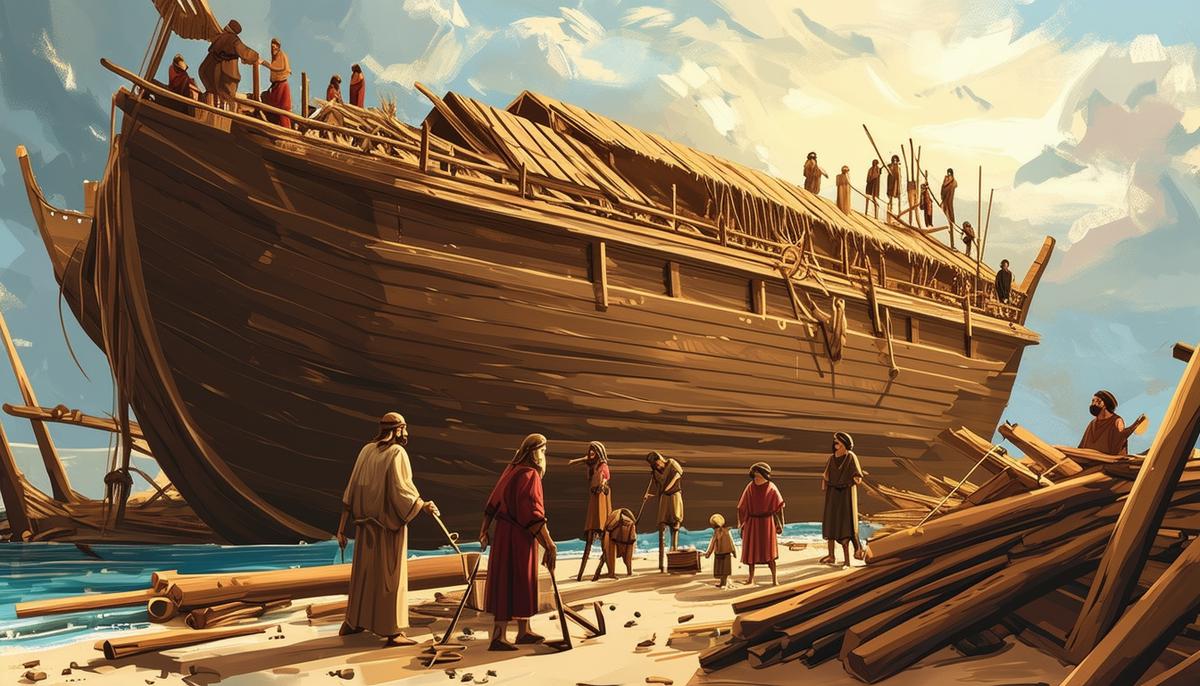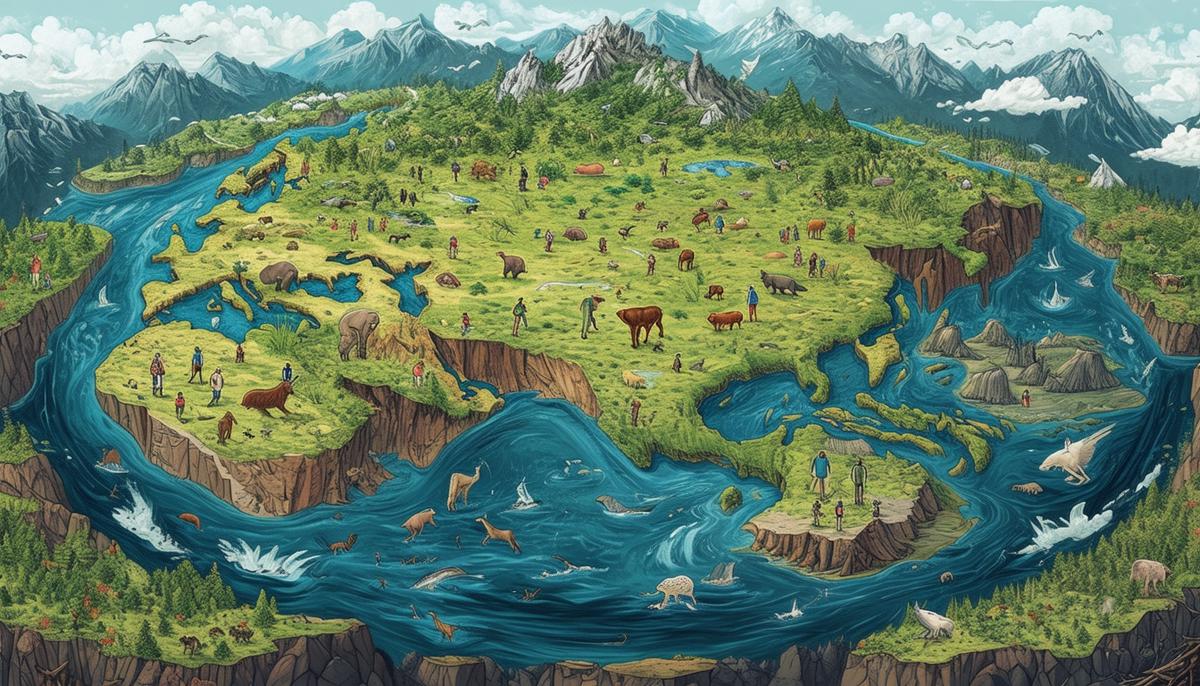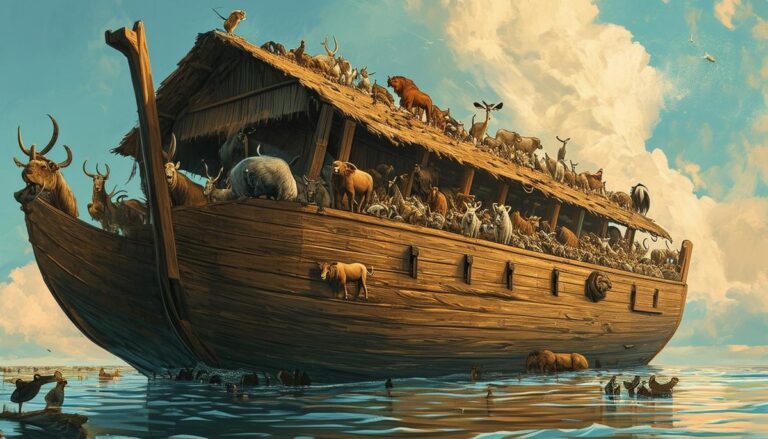Who was Noah?
Noah, according to the Biblical narrative, was a man chosen by God due to his righteousness amid a corrupt world. He is most famous for constructing the Ark, a massive ship designed to save his family and various animal species from a catastrophic flood intended to purge the Earth of its wickedness. His obedience to God makes him a pivotal figure in Biblical accounts, exemplifying faith and resilience.
Purpose of the Flood?
The flood, as presented in the Genesis narrative, was a defining moment in biblical history, where God sought to cleanse the Earth of pervasive moral corruption and violence. Witnessing the extent of human wickedness, God pronounced judgment to reset the moral landscape. This mass destruction was not just punitive; it also aligned with divine intentions to restart humanity afresh from Noah's righteous lineage, thereby setting a new course for human history under the covenantal promise that ensued post-flood.
This dramatic measure highlights both aspects of God's nature portrayed in scripture—justice, exemplified by the flood's purging of evil, and mercy, shown through the preservation and new beginning granted to Noah and his family. The narrative elevates the concept of divine justice intermingled with grace, as while the wicked were washed away, those who found favor with God were given a new covenant underscoring humanity's value and God's care despite their failings.
Ark's Animal Capacity?
The dimensions of Noah's Ark, as specified in Genesis, suggest a vessel of enormous capacity, measuring about 450 feet long, 75 feet wide, and 45 feet high. The narrative emphasizes the Ark's role in preserving representatives of the animal kingdom, but the feasibility of fitting all species within its confines is often questioned.
The Bible refers to taking "kinds" of animals onto the Ark, which isn't synonymous with modern taxonomic classifications. "Kind" is thought to equate more closely to the level of family or genus. This interpretation reduces the number of animals needed and suggests that significant genetic diversity could be encapsulated within a single "kind," which could later diversify into varied species through processes such as adaptive radiation and natural selection post-flood.
Taking primarily younger, smaller representatives of each kind could also optimize space and address care requirements during the voyage. Teenage or juvenile animals would necessitate less space and consume fewer resources, yet maintain the potential for future reproductive success essential for re-populating post-flood ecosystems.
This perspective provides intriguing solutions to understanding how Noah's Ark could manage species preservation while absorbing theological interpretations and traditional biblical exegesis.
Ark's Construction?
Noah received specific instructions from God regarding the construction of the Ark, detailed in Genesis. The blueprints called for gopher wood, a term that has puzzled scholars due to its uncertain identity; it's often thought to refer to a type of resinous wood capable of waterproofing. The Ark's dimensions were monumental: approximately 450 feet long, 75 feet wide, and 45 feet high.
These specifications underscore the enormity of Noah's task and the divine origin of his blueprint. Since no human technology at the time could predict the requirements of building such a colossal, seaworthy vessel, Noah's adherence to divine guidance was critical. The Bible notes that Noah was to coat the Ark with pitch, a natural tar-like substance, which would act as a sealant against the waters.
The construction likely spanned several decades, suggesting that Noah had to possess or develop considerable skills as a craftsman and leader, orchestrating this monumental task with his family's help. What remains unmistakable from the scriptures is the interplay of faith with obedience in God's commands as Noah undertook this challenge.
The narrative serves as a testament to ancient ingenuity and an enduring epitome of capability amplified by divine guidance—a central theme that transcends time and continues to resonate.

Ark's Proof of Existence?
Archeological pursuits and historical expeditions have yielded debates and curiosity about the physical existence of Noah's Ark. Claimed sightings and explorations, especially on Mount Ararat in Turkey, where scripture suggests the Ark came to rest, fuel ongoing searches. These explorations attract varying theories and accounts that capture the imagination of the general and scholarly public alike.
Over the years, numerous expeditions have ventured into Mount Ararat aiming to uncover evidence of the Ark. Some explorers claim to have seen fragments of ancient wood and constructions similar to a ship's structure within the ice and volcanic debris at high altitudes. However, concrete evidence that can be universally accepted in the scientific community remains elusive.
One major challenge in proving the Ark's existence is the nature of wood—being organic, it would typically decay over millennia, possibly leaving little trace after thousands of years. Analytics such as carbon dating could potentially back any timber remains' legitimacy, but contamination issues could compromise such data.
Mount Ararat's geopolitical situation renders long-term explorations difficult due to permitting restrictions and historical tensions in the locale. The mountain also exhibits harsh environmental conditions, making archaeological digs perilous and logistically challenging.
Proving the existence of Noah's Ark holds different implications for various communities. For some, it is a confirmation of faith; for others, a puzzle in human history worthy of academic pursuit. The quest for the Ark resonates a deeper human fascination with ancient mysteries and the intersection between faith, history, and science.
Whether any expedition will ever uncover definitive proof remains to be seen, keeping the mystery of Noah's Ark a provocative topic for discussion and a narrative with enduring appeal worldwide.
Global Flood Impact?
The implications of a global flood extend far beyond the immediate concerns of Noah's family and the animals aboard the Ark, touching upon geography, ecosystems, human populations, and animal diversity. The story describes a world-wide deluge that dramatically alters the Earth's landscape, a concept both fascinating and complex when examined through modern scientific and theological lenses.
From a geographical perspective, a global flood of the magnitude described in Genesis would likely lead to significant changes in topography and could be responsible for shaping many modern landforms. The Bible mentions mountains and valleys being reshaped as the waters receded, suggesting massive geological upheavals.
Scientifically, a flood covering the entire globe would have catastrophic effects on human populations and animal species. For humans, a flood of this scope would result in a severe bottleneck—a rapid reduction in population size. Such a bottleneck could have genetic implications for the survivors, reducing genetic diversity and adaptability.
Regarding animal species, integrating scientific and theological viewpoints poses questions about species survival and diversity post-flood. According to the narrative, Noah preserved a remnant of the world's animal "kinds," but considerations about biodiversity post-flood involve discussions around speciation—how new species could arise from limited genetic stock.
The ecological impact of a global deluge would be profound. Entire plant ecosystems would be uprooted and destroyed, impacting soil stability and fertility for centuries. Recovery of flora and fauna populations would be uneven across different ecosystems, dramatically influencing which animals could survive long-term.
Literature on a global flood extends into examining its role as a narrative tool in teaching lessons about divine justice, human responsibility, and environmental stewardship. In this way, the global flood story functions both as a historical-scientific query and as a theological-symbolic narrative, pointing to deeper truths about human nature and our place within the cosmos.
The intersection of faith-based interpretations of Earth's history with empirical scientific study creates a rich dialogue. As we continue to explore the implications of such monumental events, the discussion stimulates a broader understanding of our world's history and our perennial quest to understand it fully.

- The Holy Bible, New International Version. Grand Rapids: Zondervan Publishing House; 1984.
- Whitcomb JC, Morris HM. The Genesis Flood: The Biblical Record and Its Scientific Implications. Phillipsburg, NJ: P & R Publishing; 1961.
- Woodmorappe J. Noah's Ark: A Feasibility Study. Santee, CA: Institute for Creation Research; 1996.

